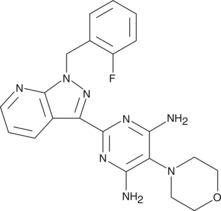Description
A stimulator of sGC, increasing the activity of recombinant sGC dose-dependently, from 0.1 nM to 100 μM, up to 92-fold; in vitro, relaxes vessels and inhibits platelet aggregation at nM concentrations; in vivo, decreases blood pressure dose-dependently, prolongs bleeding time, and reduces thrombosis
Formal name: 2-[1-[(2-fluorophenyl)methyl]-1H-pyrazolo[3,4-b]pyridin-3-yl]-5-(4-morpholinyl)-4,6-pyrimidinediamine
Synonyms:
Molecular weight: 420.4
CAS: 256498-66-5
Purity: ≥98%
Formulation: A crystalline solid
Product Type|Biochemicals|Small Molecule Activators|Cyclases||Research Area|Cardiovascular System|Blood|Coagulation & Hemostasis||Research Area|Cardiovascular System|Blood|Thrombosis||Research Area|Cardiovascular System|Cardiovascular Diseases|Hypertension||Research Area|Cardiovascular System|Vasculature|Vasodilation||Research Area|Cell Biology|Cell Signaling|cGMP Signaling||Research Area|Cell Biology|Cell Signaling|Nitric Oxide Signaling||Research Area|Endocrinology & Metabolism|Nutrient Sensing


